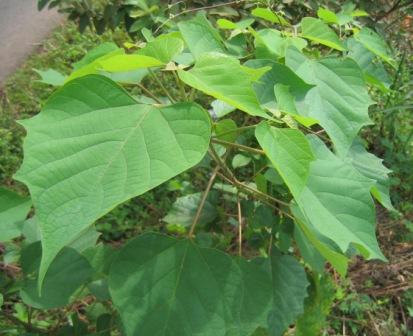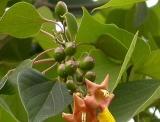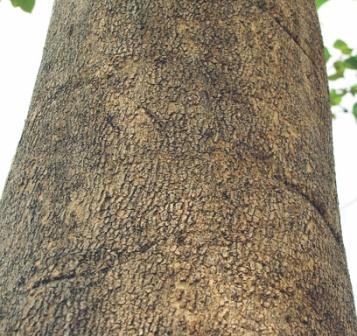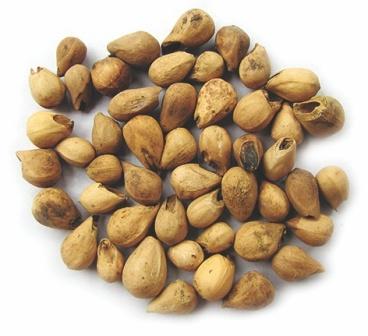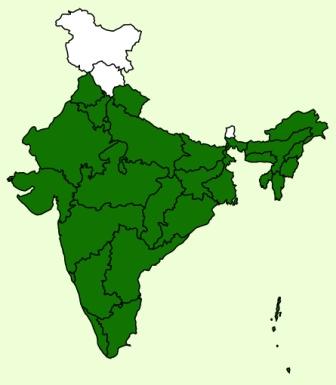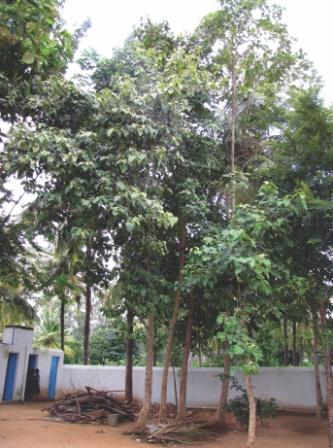Natural Regeneration :
- Naturally regenerates itself from coppice or self sown seeds in rain.
Artificial Regeneration :
- Raised artificially by Nursery raised seedlings.
Seed collection and Storage :
- Mature fruits should be collected frequently, e.g. twice every week
- In order to avoid fermentation, fruits should be brought to the cleaning area within 24 hours.
- Depulping of small quantities of fruits can be done manually by mashing the fruits until the pulp is loose from the seeds, and rinsing with water.
- For larger quantities of fruits depulping is normally done in a coffee-depulper.
- Soaking the fruits in water for 24 hours before depulping will facilitate the process.
- After depulping, the fruits are spread out on a wire-mesh tray and rinsed with water to remove juice and pulp.
- Finally the seeds are washed and dried well in the sun.
Seed Treatment :
- Soak seeds in cold water for 24hrs.
Nursery Technique :
- Propagated by both seeds and vegetative methods.
- Seeds are sown directly in the root trainer or raised beds
- The bed should be filled with sand up to height of 0.5 m.
- The seeds broadcast over the bed.
- The beds are to be watered twice a day with the help of rose cane.
- One kg of seeds contain about 1500-2000 seeds.
- The size of the seeds varies between the trees.
- Seeds normally germinate quickly and at high levels.
- Often the germination will be above 100% as more than one seed will germinate from each stone.
- The seedbed should be exposed to full sunlight as partly or full shade will reduce germination.
- After germination, the seedlings can be transplanted to poly bags
Plantation technique :
- The seedlings were planted in a pit of 45 cm3
- About 120 days old seedlings are used for planting.
- The seedlings are planted with the spacing of 3 x 3 m to 5 x 5 m.
- Establishing pulp wood and bio energy plantations 2 x 2 m spacing is also adopted.
Care & Disease Control :
Pruning:
- Pruning is an important practice in the cultivation of tree
- Pruning decides the growth, clear bole and intercropping ability.
- Pruning of side branches is usually carried out in every six months.
- The pruned branches can be used as fire wood.
Thinning:
- Thinning is another important practice to enhance the production of saw log.
- The thinning begins at 4-5 years of age for the woods that are used for pulp productions.
- The alternative trees in the row are to be thinned, to avoid competition between the trees and maximize the growth.
Irrigation :
- Daily drip irrigation for the initial 2 years.
- No Tolerance to water logging.
Recommended Harvest :
- The trees are harvested 4 – 5 years after planting for pulpwood.
- The trees harvested at 10 – 12 years after planting for log productions
Yield :
- Under good management regime each trees yield about 1.5 to 2 tons.
- The total yield per hector is around 250 – 300 tons / ha.*
*Subject to varry according to site factors.
Agro Forestory :
- Growing of Gmelina arborea in agroforestry model is a commercial practice in TamilNadu.
- Some of the agroforestry models are Gmelina + Ground nut, Gmelina +Water melon, Gmelina +Pulses, Gmelina +Maize, Gmelina +Banana.
- Multi - tier cropping system also has been followed in Pudukkottai district of Tamil Nadu.
- Coconut + Gmelina + Banana + Pepper (pepper trained on the Gmelina trees).
Major uses :
- The tree has immense potential for its timber and medicinal value.
- It is a preferred species by farmers, forest departments and ayurvedic industries due to the multipurpose utility, rapid growth, and maximum economic returns.
- The wood is used for pulp, particle board, plywood, matches, carpentry and packing. It is also used for construction at boards, carwing and musical instruments.
- The leaves and fruits are used as a fodder, and also used for rearing silkworms.
- The species also planted in Taungia system with short rotation crops, and also as a shade tree for coffee and cocco.
Market details :
- Aproximately Rs.7000 to 8000/ton*
*Subject to change according to market demands


